Landowner Responsibilities
A ‘riparian owner‘ is somebody who has a watercourse running through, beneath or adjacent to their land. If the watercourse forms the boundary with your land, you will usually own up to the centre of the channel. If in doubt, you will need to check your title deeds to confirm exact ownership. This can be done via the land registry.
The responsibility of a riparian owner includes the safe maintenance of the bed and banks of a watercourse that falls within their property boundary.
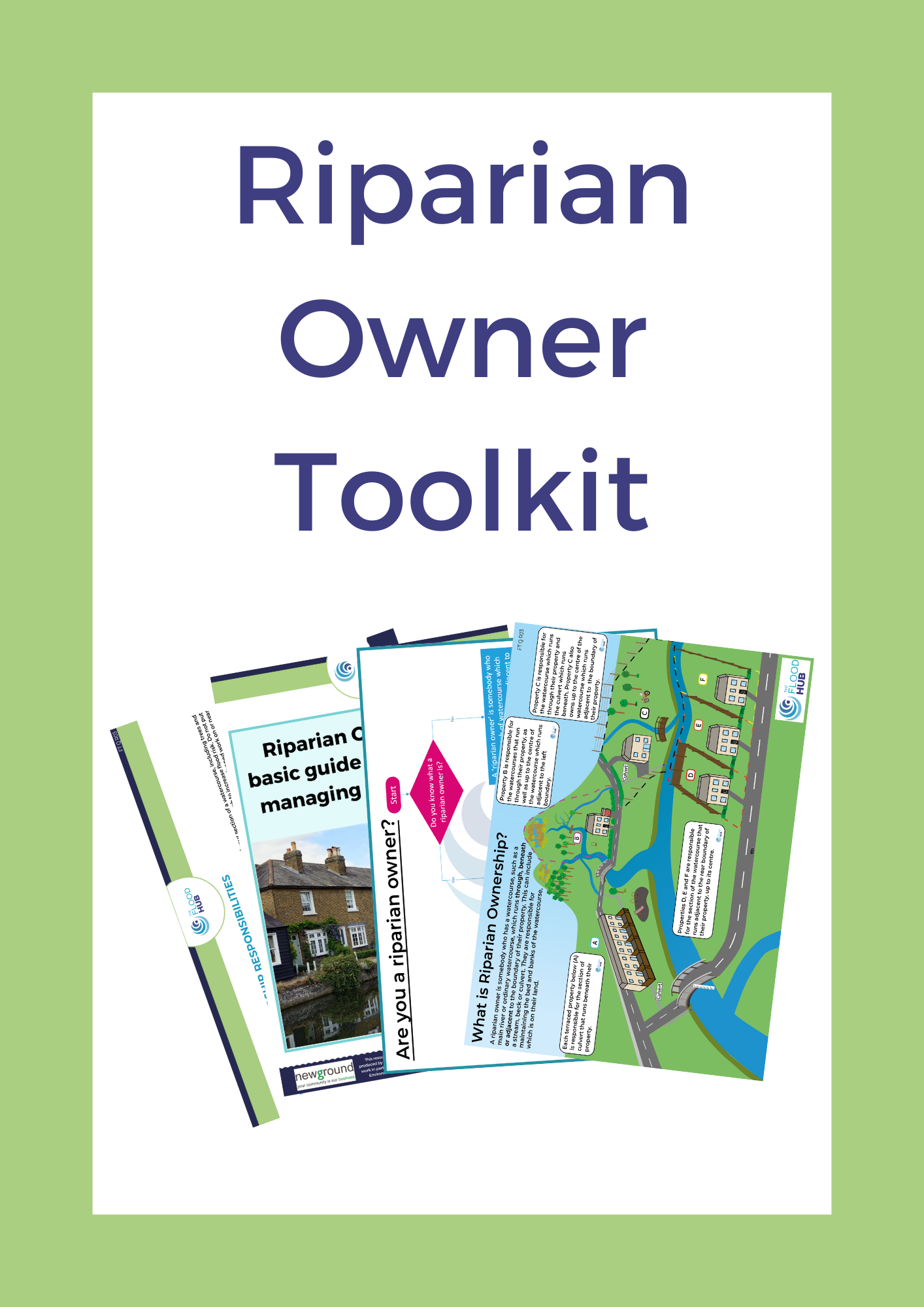
All of the different Riparian Ownership resources featured on this page can be found in our ‘Riparian Owner Toolkit’ which can be found here.
To find out if you are a riparian owner, follow the flow chart below:
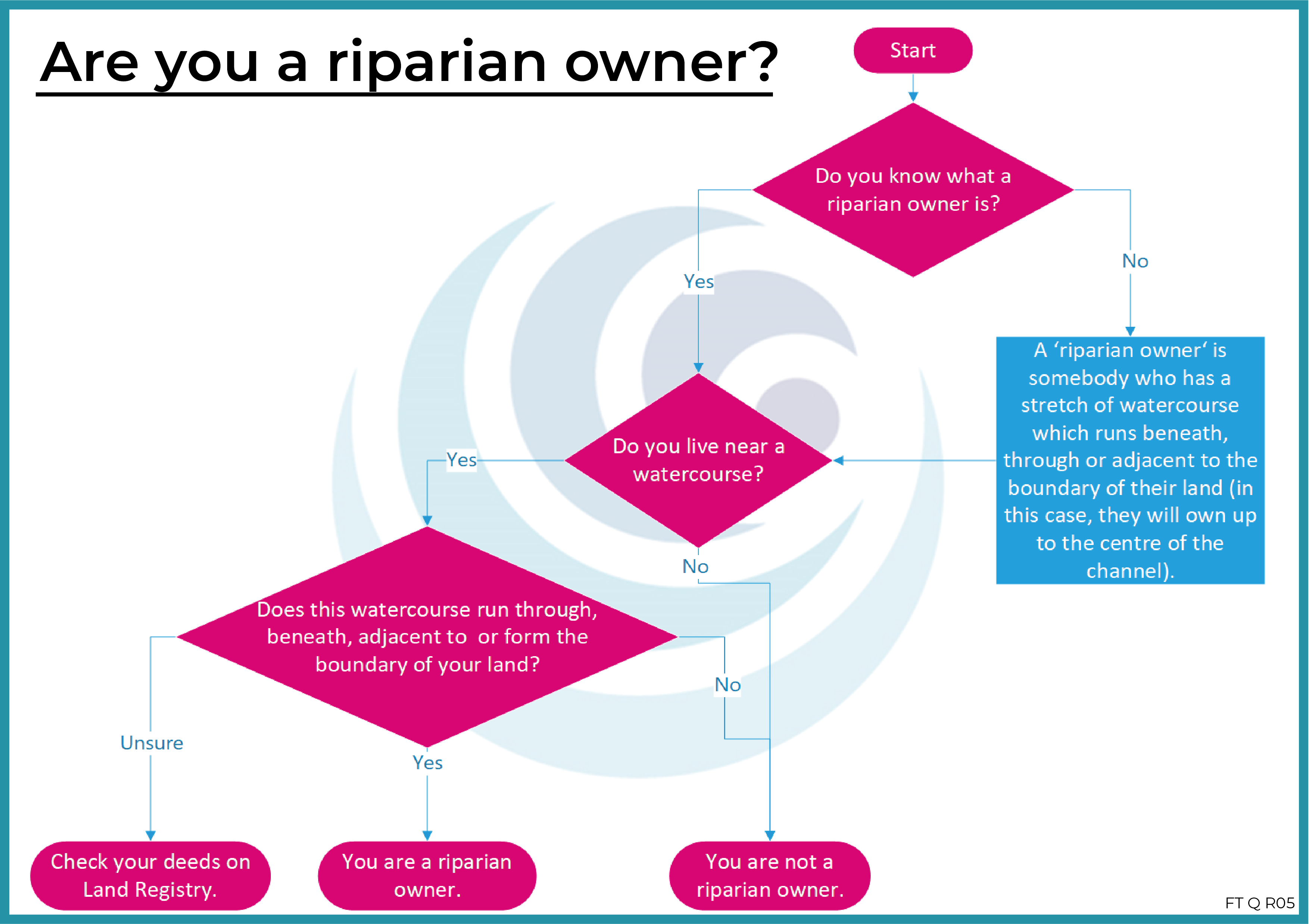
If you require advice about owning a watercourse you should contact the relevant risk management authority (RMA), which is:
- The Environment Agency for main rivers. To identify whether your nearest watercourse is a main river, click here.
- The Lead Local Flood Authority (LLFA) or Internal Drainage Board (IDB) for any other watercourse.
For more information on main rivers and ordinary watercourses, visit our ‘Types of watercourses’ resource here.
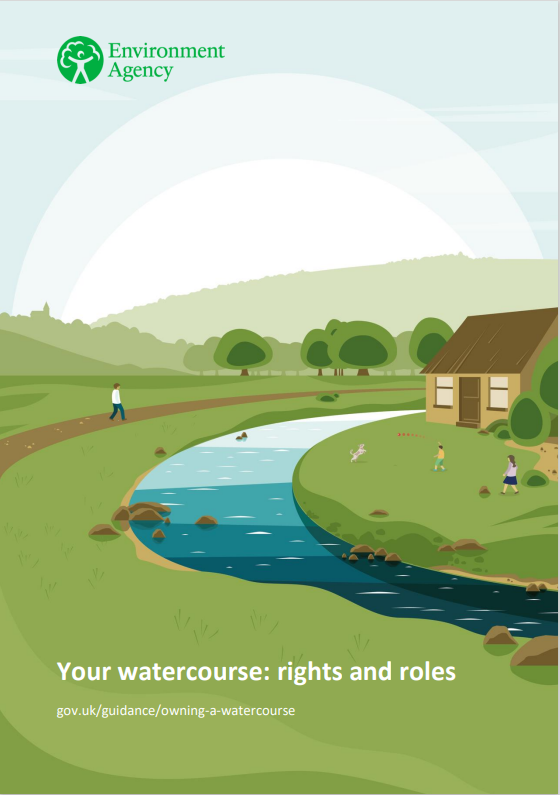
Click here to view the Environment Agency’s ‘Your watercourse: rights and roles’ guide which supplements the Environment Agency’s ‘Owning a watercourse’ guidance. This guide will be helpful for you to understand your roles and responsibilities as a riparian owner.
Click here to download the ‘Riparian Ownership: A basic guide to owning and managing a watercourse’ resource.
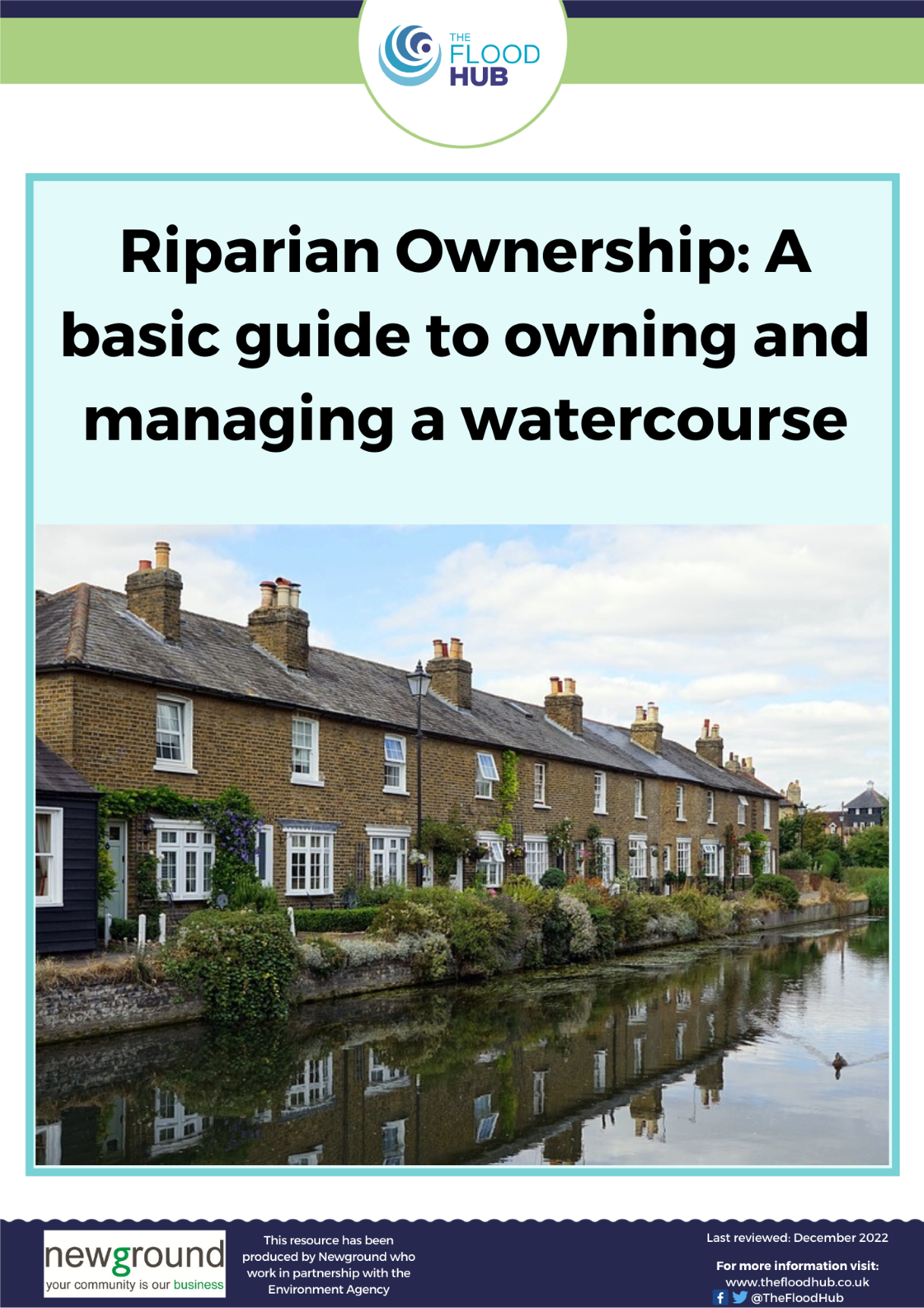
If you own a watercourse, it is your responsibility to ensure that water flows through it naturally, and for maintaining it by removing blockages that may impede the flow of water or cause flooding. However, you are not responsible for taking proactive measures to reduce the risk of flooding from the watercourse.
Responsibilities can include :
- Maintaining your section of watercourse
- Letting water flow naturally and not obstructing the flow of a watercourse to the detriment of your neighbours.
- Not affecting the quantity or quality of the flow in a watercourse.
- Keeping structures clear from obstructions and debris.
- Not allowing the watercourse to become polluted.
- Reporting incidents such as flooding, blockages which could cause flooding, pollution, unusual changes in flow, collapsed or badly damaged banks or any activity on or near a watercourse that does not have permission.
For more information click here to download our ‘What is a Riparian Owner?’ resource.
To learn more about who is responsible for the management of flood risk from different sources, see our flood risk responsibilities section here, or visit GOV.UK for details.
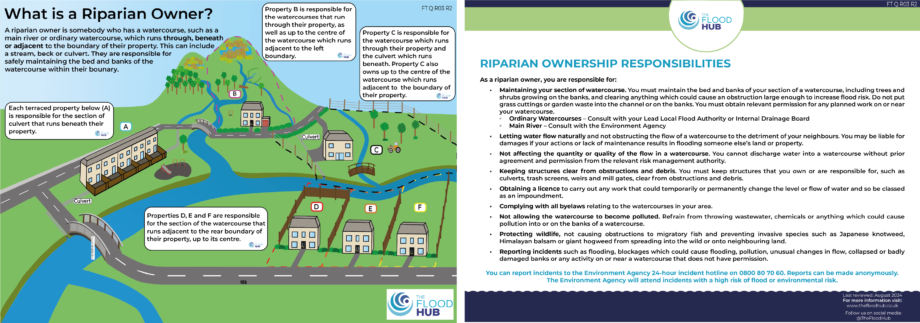
If there is a lack of maintenance, or changes are made to the watercourse that cause or contribute to flooding, you may be held financially responsible for the damages and could face legal action.
You have a responsibility to report any instances of flooding from your watercourse. If the flooding is from an ordinary watercourse, contact your Lead Local Flood Authority (LLFA). If the flooding is from a main river, contact the Environment Agency Incident hotline on 0800 80 70 60. This is a 24-hour service and should be used to report flooding, blockages, pollution, changes in flow and damaged banks.
If you wish to undertake any work in or around a watercourse, it is your responsibility to contact the relevant authority to determine if any consents or permissions are required (see our ‘Consents and Permissions’ section for more information).
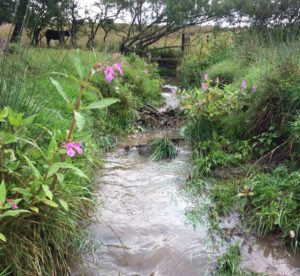
Image: The Flood Hub – Ordinary Watercourse / Stream in Ribchester, Lancashire
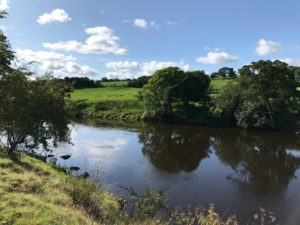
Image: The Flood Hub – Main River / River Ribble in Ribchester, Lancashire
There are a set of soil management rules that farmers should adhere to whilst managing their land. The rules include taking reasonable precautions to prevent soil erosion, water pollution and manage surface runoff. Find out more about these rules by clicking here.
If you own coastal land with a watercourse running through it, you have the same responsibilities as other watercourse owners. These responsibilities include maintaining the watercourse by keeping it clear of blockages that may cause flooding and allowing water to flow naturally.
The Environment Agency is responsible for managing flood risk from the sea and for the strategic overview of all flooding and coastal erosion management. They issue permits for works on flood and sea defences. If you have something on your land that helps prevent flooding or coastal erosion, like a wall, building, embankment or raised area, the Environment Agency can also designate structures on your land as flood or coastal erosion defence assets. As these assets affect flood or coastal erosion risk, consent will usually be required if you wish to alter, remove or replace them on your own land. Find out more about designated assets here.
Consents and Permissions
If you wish to undertake any work in or around an ordinary watercourse, it is your responsibility to contact the Lead Local Flood Authority (LLFA) or the Internal Drainage Board (IDB) to check if the activity is regulated and which permissions or licences may be required. For ordinary watercourses, land drainage consent may be required from the local council or IDB.
If you are planning to carry out any work in or around a main river, it is your responsibility to contact the Environment Agency to check if the activity is regulated and which environmental permits may be required.
Activities carried out in or near main rivers that have the potential to cause flooding or increase flood risk are regulated under environmental permitting. Before you begin work, you can see whether or not the activity needs a permit by checking whether it is listed as a flood risk exclusion, or whether you are able to register it as a flood risk exemption. For more common flood risk activities, there are also standard rules permits, which come with a set of rules, guidance and a risk assessment. Bespoke permits are specifically designed for activities which are not covered by exemptions, exclusions or standard rules. Before you apply for a bespoke permit you must complete a risk assessment and develop a management system for the proposed activity.
For more information, contact the relevant risk management authority (RMA).
Funding
As a landowner there are different ways you can get involved in managing flood risk in your area and there are different management techniques you can implement . There are also various programmes that can provide funding to support these efforts. Some examples are listed below.
As part of the Agricultural Transition Plan 2021 – 2024, direct payment funding will be gradually reduced and then stopped by 2027. This change will bring in three new levels of support:
- Sustainable Farming Incentive (SFI) – paying for sustainable farming practices.
- Local Nature Recovery – improving the local natural environment.
- Landscape Recovery – creating landscape-scale changes such as new woodland creation.
By 2028, the government aims to ensure farmers are running sustainable businesses which operate without the need to rely on public subsidy. But they can still access public money to help them deliver environmental and animal welfare outcomes. Such public benefits include the recovery of nature.
New Sustainable Farming Incentive
The Sustainable Farming Incentive (SFI) provides financial support to farmers who adopt and maintain sustainable farming practices that aim to protect and improve the environment, for example taking actions that support food production and improve farm productivity and resilience. Farmers can apply for a 3-year SFI agreement to implement environmental land management actions that contribute to a more sustainable approach. For more information on the Sustainable Farming Incentive, please click here.
As of March 2025, the SFI expanded offer is currently closed to new applications.
Local Nature Recovery
The Local Nature Recovery Scheme is designed to compensate farmers for taking actions that help nature in their local areas, like making homes for wildlife or establishing wetland spaces.
The scheme plans to make an early version of the programme available to a limited number of people in 2023 for testing and gradual implementation. The scheme aims to be rolled out across the whole country by the end of 2024.
Funding will be available for locally targeted actions that promote the creation of space for nature in the farmed landscape. Such actions could include:
- Managing and creating habitats.
- Planting trees or hedgerows.
- Restoring peat or wetland areas.
- Restoring rivers, floodplains, streams and riparian habitats.
- Installing nature-based solutions like buffer strips and swales to reduce and filter runoff, which contributes to natural flood management.
Click here for more information.
Landscape Recovery
The Landscape Recovery Scheme will support farm level action to make farming more sustainable. This is in addition to Local Nature Recovery, which will support local level action to make space for nature alongside food production. The Landscape Recovery scheme is for landowners and managers who want to take a more radical and large-scale approach to supporting significant habitat restoration and land use change. The first round of the project will be focused on two themes:
- Recovering and restoring England’s threatened native species.
- Restoring England’s streams and rivers which will improve water quality, biodiversity, climate change adaption and improve flood mitigation.
Click here for more information.
To read more on natural flood management, click here.
The Countryside Stewardship (CS) scheme provides financial incentives to landowners and land managers who actively participate in environmental conservation, including flood risk management. Through CS, you can engage in various activities that look after and improve the environment, including managing the risk of flooding. These activities can include: the creation of wetland habitats, grip blocking, riverbank restoration, instream structures and woodland creation.
Click here for more information.
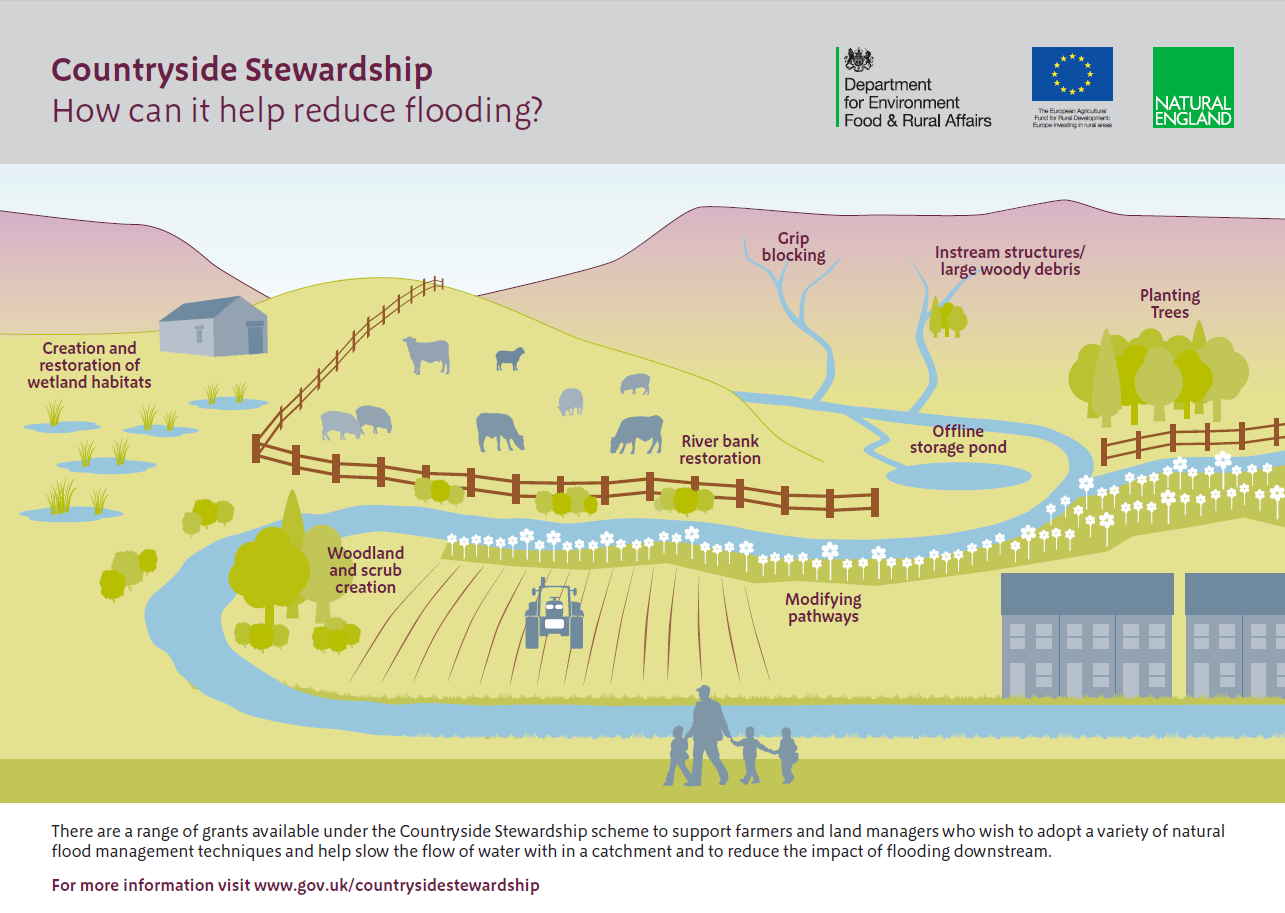
Download the infographic about Countryside Stewardship here.
Woodland Creation Grant
The Woodland Creation Grant is part of the Countryside Stewardship scheme and is designed to support planting and protecting trees. One-off payments are given to successful applicants to pay for the trees that will be planted and any associated protection items. This grant can be used for the creation of woodland to manage flood risk.
Once the woodland is planted, eligible applicants can also apply for multi-year support to maintain the trees for 10 years; this is the Woodland Creation Maintenance Grant.
Additionally with the permission of Natural England, leaky woody dams can be implemented as part of the scheme which are designed to slow the flow of water, managing flood risk.
Find out more about these grants here.
Nature for Climate Peatland Grant Scheme (NCPGS)
The Nature for Climate Peatland Grant Scheme (NCPGS) is a government initiative that offers funding to restore peatlands in both upland and lowland areas of England. This grant will continue until 2025, providing financial support and guidance to landowners and managers for activities like rewetting and vegetation management. The main objectives are to decrease emissions, enhance water quality and promote biodiversity.
The Restoration Grant aims to revive degraded peatlands in England. Applicants can request funding for up to 75% of the project costs, and in special cases, up to 85%.
Click here for more information on the scheme and how to apply.
Woodland Trust
There are various tree planting funding schemes available through the Woodland Trust for farmers, landowners, businesses or local authorities. These include:
- Subsidised tree packs
- Trees for your farm
- MOREwoods in the Northern Forest
- MOREhedges
- Woodland Carbon Scheme
Visit the Woodland Trust website here to find out more.
Catchment Sensitive Farming
Catchment Sensitive Farming (CSF) is a programme implemented in specific priority catchment areas throughout England. It aims to provide financial savings for farms while delivering environmental benefits for the entire community. Individuals from the farming community are given free, tailored advice and training through workshops, demonstrations and farm events. They can also be offered capital grants to implement improvements on their land.
CSF supports farmers applying for Countryside Stewardship to improve water quality and biodiversity and to manage flood risk.
Click here for more information.
Other organisations, such as the Rivers Trust, Woodland Trust, National Trust, Forestry Commission and Wildlife Trust, may be running schemes in your area that have multiple benefits for flood risk management. You should be aware of schemes happening in your area as there may be opportunities for you to be involved in.
Flood Recovery
Flood events can result in widespread, extensive damage to land, which can lead to significant emotional and financial impacts on landowners and farmers. There is advice and support available for those who have been affected, to help ease the recovery process.
The Environment Agency has produced a ‘Flood recovery advice for the agricultural sector’ guide. This provides information for landowners and farmers so that they can undertake the necessary works to recover from flooding quickly and safely, without causing a greater risk of flooding elsewhere.
Click here to download the Environment Agency ‘s ‘Flood recovery advice for the agricultural sector’.
The National Farmers Union (NFU) also provides flooding advice for landowners and farmers across the country. This can be viewed here.
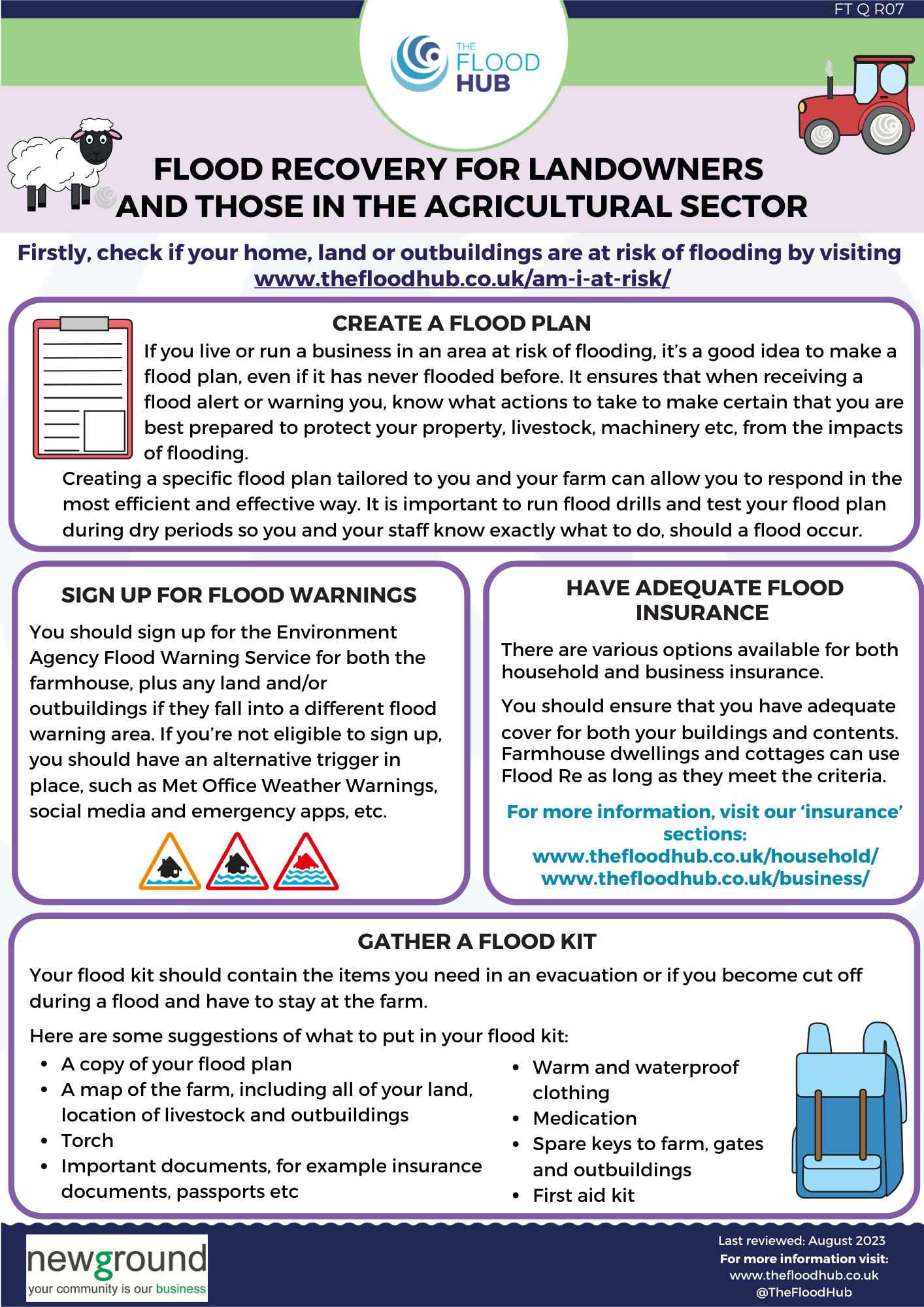
Click here to download our resource on ‘Flood Planning and Recovery for Landowners and those in the Agricultural Sector’.
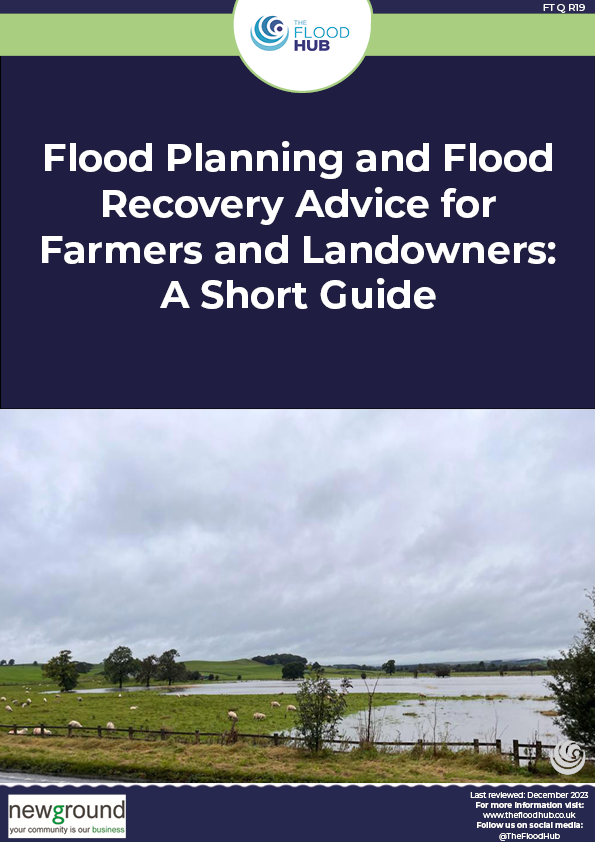
Click here to download our ‘Flood Planning and Flood Recovery Advice for Farmers and Landowners: A Short Guide’ booklet.




